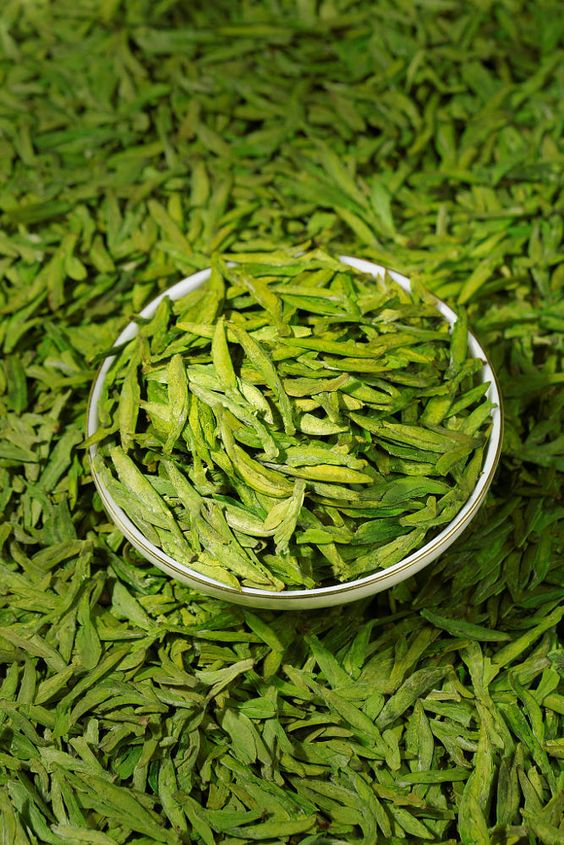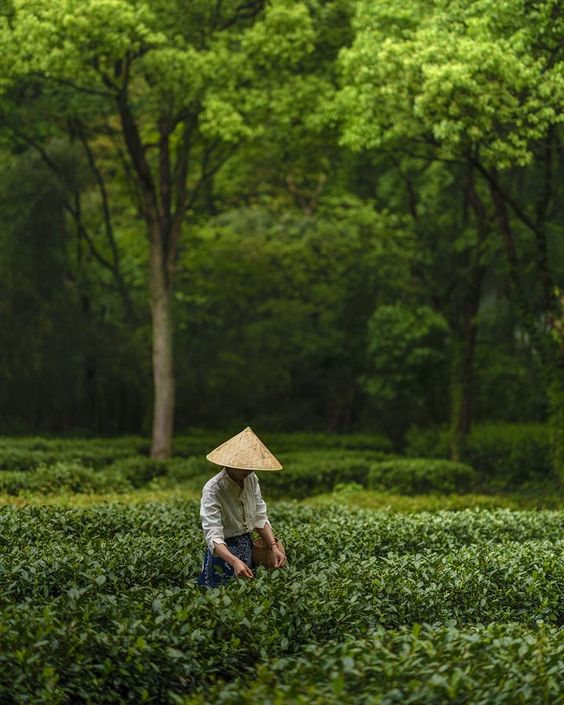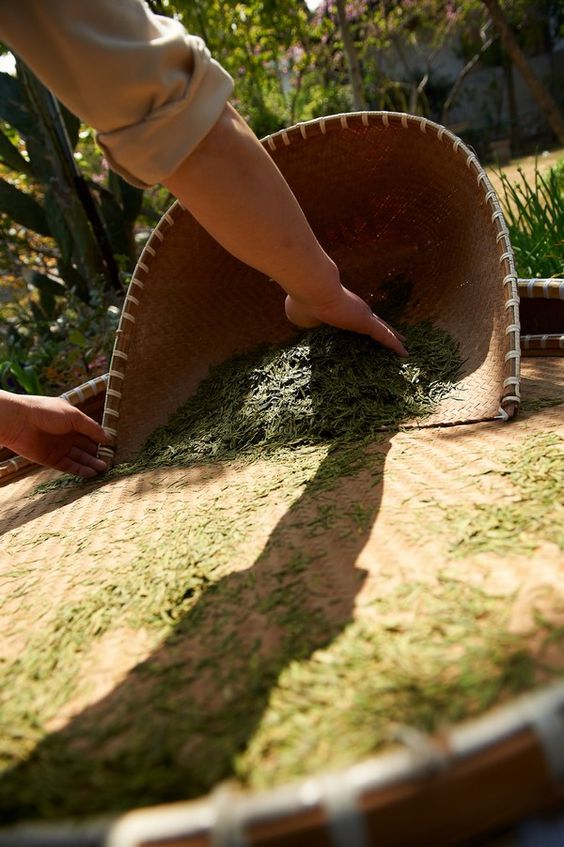Cai Sang Zi - Who can appreciate the goodness of West Lake?
Song Dynasty: Ouyang Xiu
The West Lake is the best place in the world, and there is no time for good scenery. It is a good time to enjoy the beautiful scenery. I am greedy to get drunk in the jade goblet among the flowers.

Who knows that the grass is slanting at the appendage?
The water is far away and the smoke is faint. A little Cangzhou white heron fly. West Lake Longjing is a green tea, one of the ten most famous teas in China. It is produced in the mountains around Longjing Village, West Lake, Hangzhou, and Zhejiang Province. It has a history of more than 1200 years. When Qianlong visited the West Lake in Hangzhou, he praised the West Lake Longjing tea and made the eighteen tea trees in front of the Hu Gong Temple under the Shifeng Mountain the ‘Imperial Tea’. Xihu Longjing tea is divided into 1 to 8 levels according to its appearance and internal quality. The shape is flat and pretty, the colour is green and emerald, the inner quality is fragrant and mellow, and the buds and leaves are green in colour when brewed in the cup. It is known for its ‘green colour, lush fragrance, sweet taste and beautiful shape’.
West Lake Longjing tea has a long history, which can be traced back to the Tang Dynasty in China, when the famous tea sage Lu Yu, in the world's first tea monograph written by the ‘Tea Scripture’, there are two temples in Hangzhou Tianzhu, Lingyin tea production records. The name of Xihu Longjing tea began in the Song Dynasty, heard in the Yuan Dynasty, raised in the Ming Dynasty, and flourished in the Qing Dynasty. In the process of historical evolution of more than a thousand years, Xihu Longjing Tea began its glorious period from nameless to famous, from the common people's after-dinner household drink to the tribute of the emperors and generals, and from the famous tea of the Han nation to the world's famous product.

As early as the Northern Song Dynasty, the Longjing tea area had the initial formation of scale when Lingyin lower Tianzhu Xianglin Cave ‘Xianglin tea’, on the Tianzhu Baiyun Peak production ‘Baiyun tea’ and Ge Ling Bao Yun Mountain production ‘Bao Yun tea’ has been classified as tribute. ‘has been listed as tribute. The Northern Song Dynasty monk defence the Venerable Master to go back to his hometown, but also that year Su Dongpo and other literary heroes at the foot of the Longjing Lion Peak Shousheng Temple tea poetry place, Su Dongpo had a ‘Baiyun Peak under the two flags of the new, greasy green and long fresh valley rain spring’ sentence praise Longjing tea, and handwritten ‘old Longjing’ and other plaques! The Shou Sheng Temple Hu Gong Temple, eighteen imperial tea plantations at the foot of the Lion Peak on the hanging rock.
Southern Song Dynasty, Hangzhou became the capital of the country, and tea production further developed. In the Yuan Dynasty, the quality of Longjing tea was further improved. Tea produced near Longjing began to show, a tea lover Yu Bersheng began to make a ‘tour Longjing’ tea poem, the poem said: ‘wandering on the Longjing, cloudy and clear painting. Chenggong loves guests to, take water to the sinuses. Sitting in my Zhan Bu, the after-smell does not smell. But I can see that the water in the dipper is clear, and the green shadows are falling on the blue mountain. The golden buds were cooked and fried, not after the rain, and the two or three sons who came with me could not bear to rinse out the water.’ Visible at that time, the monks and priests in the Longjing area scenery quiet, and a good spring tea, so the company came to drink tea and enjoy the scenery.

Ming Dynasty, the West Lake Longjing tea began to emerge, and reputation gradually spread far and wide, and began to go out of the monastery, for ordinary people to drink. Ming Jiajing years of ‘Zhejiang plaque’ records: ‘Hangzhou county tea, always less than the production of Longjing, and before the rain fine buds, take a flag of a gun, especially the treasures, the production is not much, it is appropriate to its precious also.’ Ming Wanli year of ‘Hangzhou Prefecture’ has ‘old Longjing, its real estate tea, for the two mountains,’ said. Wanli year ‘Qiantang County Records’ also recorded ‘tea out of Longjing, for the soybean flower fragrance, colour and taste sweet, and other mountains.’ At this time the West Lake Longjing tea is listed as China's famous tea. Ming Dynasty Huang Yizheng included in the famous tea record and the south of the country's famous tea recorded by Xu Wenchang, both have Xihu Longjing tea.

Qing Dynasty scholar Hao Yi wants to line examination of ‘the name of the tea, there are Zhejiang Longjing, Jiangnan mustard piece, Fujian Wuyi cloud.’ Emperor Qianlong six times to Jiangnan, and four times to the West Lake Longjing tea area to watch the tea harvesting and tea poetry. Hu Gong Temple in front of the eighteen tea trees was also sealed as ‘imperial tea’. From then on, the West Lake Longjing tea is famous at home and abroad, asking for tea in an endless stream. Nearby Xu Ke said: ‘The green tea produced by the provinces, few for the deep blue colour, only our Hangzhou Longjing, colour deep blue.
Tea of other places are curled and round, only Hang's Dragon Well flat and straight.’ In the Qing Dynasty, according to legend, when Emperor Qianlong toured Hangzhou, he composed a poem in the Longjing tea area of Tianzhu, which was called ‘Watching Tea Picking for a Song’. Xihu Longjing tea to ‘lion (peak), dragon (well), cloud (perch), tiger (run), mei (home)’ rankings Pin Di, to the West Lake Longjing tea for the most. Longjing tea shape is straight and sharp, flat and handsome, smooth and even, and the colour is green and yellow. After brewing, the aroma is clear and long-lasting, fragrant as orchids; the soup colour is apricot green, clear and bright, the bottom of the leaf is tender green, even into a flower, buds upright, lifelike. The tea is so refreshing and fragrant that it leaves a long-lasting aftertaste.
